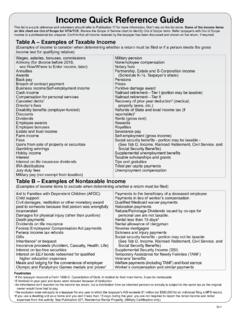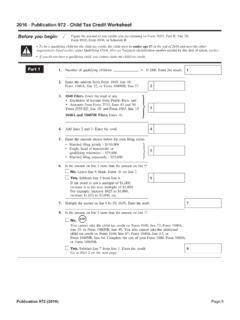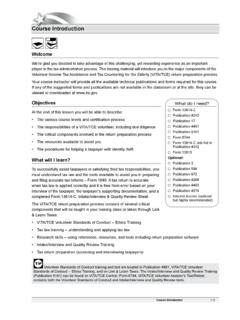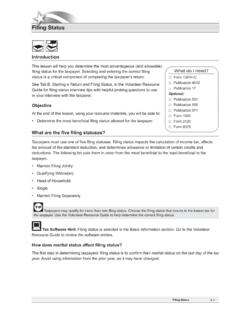Transcription of Income – Schedules K-1 and Rental - IRS tax forms
1 Income Schedules K-1 and Rental13-1 IntroductionThis lesson covers the reporting of: Certain Income from Schedules K-1 ( forms 1065, 1120S, and 1041). Volunteers who certify at the Advanced level are permitted to prepare a Schedule E only with Schedule K-1 Income items identified in this lesson or form 1099-MISC, Box 2, Royalties, with no associated expenses. Rental Income and expenses are in scope only for military families renting their personal residence. Taxpayers are not required to report Income and expenses if their home is rented less than 15 days. Rental Income and expenses are in scope only for the Military course. Volunteers must certify at Military level to prepare Schedule E for Rental Income . Rental Income and expenses are in-scope only for military families renting their personal residence. Generally, the at-risk and passive activity issues in this lesson are beyond the scope of the VITA/TCE programs.
2 These issues are referenced for those assisting military members living abroad who have limited access to resources and profes-sional is important to ensure that all Income is accurately reported on the return. Ask taxpayers if they rented out their home during the tax year or if they received a Schedule K-1 ( form 1041, form 1065, or form 1120S) from an estate, trust, partnership, or S corporation. This lesson does not apply to taxpayers who are in the business of renting Schedules K-1 and RentalWhat do I need? form 13614-C Publication 4012 Publication 17 Schedule A Schedule EOptional: Publication 527 Publication 541 Publication 551 Publication 559 Publication 925 Publication 946 form 8582 Schedule K-1 ( form 1041 and Instructions) Schedule K-1 ( form 1065 and Instructions) Schedule K-1 ( form 1120S and Instructions)Objectives At the end of this lesson, using your resource materials, you will be able to: Identify Schedule K-1 Income items that are within the scope of the VITA/TCE programs Determine how to report Schedule K-1 Income items Determine which types of Rental Income must be reported Identify how to report Rental expenses Income Schedules K-1 and Rental13-2 Schedule K-1 What is reported on Schedule K-1?
3 Schedule K-1 is used to report the taxpayer s share of Income , other distributions, deductions, and credits from partnerships, S corporations, and some estates and trusts. One copy of Schedule K-1 is sent to the IRS and is later matched with individual returns. Another copy of Schedule K-1 is sent to the taxpayer. Ask taxpayers if they received a Schedule K-1 from such an entity that reflects their share of Income , reportable on their form 1040. It is important to correctly report this Income to avoid notices or correspondence from the and where can Income be reported? Income reported on Schedule K-1 will be included on the taxpayer s return in various places depend-ing upon the type of Income . Income reported on Schedule K-1 that is within the scope of the VITA/TCE programs includes: Interest Income Dividend Income Qualified Dividends Income Net short-term capital gains and losses (Schedule D, line 5) Net long-term capital gains and losses (Schedule D, line 12) Tax-exempt interest Income Royalty Income (Schedule E)In Part I of Schedule E, enter a code 6 for royalties.
4 Refer to the Schedule E Instructions for more information. Royalty Income is in scope for the VITA/TCE programs only when the source document of the royalty Income is reported on Schedule K-1 or form 1099-MISC, Box 2, Royalties, with no associated expenses. Depletion allowances and any other Income , deductions, credits, etc., reported on Schedule K-1 is out of scope for the VITA/TCE programs, and the taxpayer should be referred to a professional tax preparer. Note: Foreign taxes reported on Schedule K-1 may be within scope. See the Foreign Tax Credit lesson for more K-1 ( form 1041)The fiduciary of a domestic decedent s estate, trust, or bankruptcy estate uses form 1041 to report Income , gains, losses, etc., of the estate or receive form 1041, Schedule K-1, to report their share of Income from interest, dividends (ordi-nary and qualified), and capital gains (net short-term and net long-term).
5 The taxpayer s Income from these sources should be reported on the appropriate forms and Schedules as listed on form 1041, Schedule K-1, page 2. Income Schedules K-1 and Rental13-3 Schedule K-1 ( forms 1065 and 1120S)Partnerships use form 1065, Schedule K-1, to report the taxpayers share of the partnership s Income , deductions, credits, etc. In general, a partnership is not subject to Income tax and is a flow-through entity. This means the Income flows through to the partners, who pay tax on their allocated share of the partner-ship Income on their individual forms corporations use form 1120S, Schedule K-1, to report the taxpayers share of the corporation s Income (reduced by any tax the corporation paid on the Income ), as well as any deductions, credits, etc. The S corporation is also a flow-through entity with the reported Income flowing through to each shareholder. Shareholders pay tax on their allocated share of the Income on their individual forms receive a Schedule K-1 ( form 1065 or form 1120S) reporting their share of Income from interest, dividends (ordinary and qualified), and capital gains (net short-term and net long-term) from partnerships and corporations.
6 Schedule K-1, page 2, lists the appropriate forms and Schedules where taxpayers Income from these sources should be reported. Schedules K-1 are not filed with the tax return. Advise taxpayers to keep Schedules K-1 with their is Rental Income ?Generally, payment received for renting a room or a home to a tenant is Rental Income reportable on form 1040, Schedule E. citizens and resident aliens must report Rental Income , regardless of whether the Rental property is located in the or in a foreign country. Gross Rental Income may include other payments in addition to the normal and ordinary rents received, such as: Advanced rent Security deposits, if it represents Rental Income Payments for breaking a lease Expenses paid by the tenant Fair market value of property or services received instead of Rental payments Residential rentals are in scope with Military certification when the taxpayer is in the active military only.
7 The security deposit is not included in Income when the taxpayer plans on returning the deposit at the end of the lease. However, if the security deposit is intended to serve as the last month s rent, then it should be included in Income when taxpayer s method of accounting affects when the Rental Income is reported. The cash method reports Income when received and expenses when paid; most individuals use this method. The accrual method reports Income when earned and expenses when incurred, and is out of scope for the VITA/TCE programs. Refer taxpayers using the accrual method of accounting to a professional tax preparer. In completing Schedule E, the following should be answered: Question A Check the box Yes or No to the question: Did the taxpayer make any payments in the current year that would require the filing of form 1099? If Yes, the return is out of scope. Question B If Yes, did or will the taxpayer file all required forms 1099?
8 Check the box Yes or No. Income Schedules K-1 and Rental13-4 In Part I, line 2 The number of fair Rental value days and number of personal use days is reported on Schedule E. Tax Software Hint: Use Schedule E to report Rental Income only when the taxpayer is not in the business of renting personal property. Personal property includes the Rental of items such as equipment and vehicles. For software entries, see the Volunteer Resource Guide, Tab D, Income . It is important that property be rented at fair Rental value. If a property is rented at less than fair Rental value, the Income and expenses are reported in a different manner than discussed in this lesson. Refer taxpayers who rent their property at less than fair Rental value to a professional tax qualifies as a Rental expense? Taxpayers who reside in homes they own generally itemize and deduct mortgage interest and property taxes on Schedule A.
9 However, when a taxpayer rents out a home, those become Rental expenses along with the cost of certain other operating expenses. Taxpayers who do not use the Rental home as their resi-dence should: Include the rent as Income and Deduct all of the Rental expenses, even if they exceed incomeMortgage interest and property taxes Mortgage interest on a loan used to buy or improve the property and property taxes are deductible as Rental expenses. If the residence (or a portion of the residence) was used as Rental property for any part of the year, the taxpayer must allocate the property tax and mortgage interest deductions between Schedule A and Schedule general, taxpayers use Schedule A, Itemized Deductions, to report the portion of the mortgage interest and property taxes that apply to their use of the home. That portion can be based on a percentage of time (4 months as a residence and 8 months used as Rental ) or based on an area (1,500 sq.)
10 Ft. as a residence and 500 sq. ft. as the Rental portion). For the part of the year and/or the portion of the home that is rented out, taxpayers report Rental Income and expenses (including a portion of the mortgage interest, property taxes, and other expenses that relate to the Rental time/portion of the home) on Schedule E, Supplemental Income and any part of the property tax is designated for local benefits that increase the value of the property, such as streets and sidewalks, that portion of the tax is added to the basis of the property rather than deducted as an ordinary Rental expense or an itemized interest is reported to the taxpayer on form 1098, Mortgage Interest Statement. This statement may also include property taxes. If it does not, the taxpayer should have a document from the local taxing authority. Generally, mortgage interest expense is fully deductible. However, refer taxpayers with Rental -related interest expenses other than mortgage interest to a professional tax Schedules K-1 and Rental13-5examplePaul Kingman lived in his home through September, when he was notified he was being transferred overseas.










